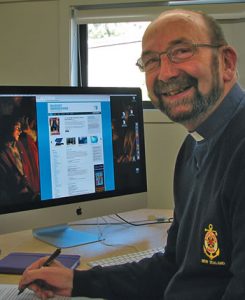The Light of the World

Fr Kevin Head SM
In ancient times, many people regarded the sun as the most important god. The sun gave the world warmth and light. Fires were lit during winter to boost the weakening strength of the sun. Sol, the sun-god, was the principal deity of the Roman Empire, and 25 December, by which day the sun had begun to come back to the skies of the northern hemisphere, was Sol’s birthday.
The heathen festival of the sun-god was the date chosen by the early Church to celebrate the birth of Jesus Christ. We do not know the date of Our Lord’s birth; what we do know is that for those who believe in him, the candles and lights of Christmas are symbols of the light and the warmth of another sun, the Son of God made man. Many of our Christmas decorations relate to Christ as the ‘light of the world’ -- the lights on Christmas trees, on houses, the candles’ light in our churches and in our homes – all are related to the coming of light at Christmas with the birth of Jesus. In the deep darkness of Christmas Eve, we rejoice in the birth of the light of the world.
The picture on the cover of this Christmas Messenger is from a painting by Gerard van Honthorst, a 17th century Dutch artist. He became famous for his skill in portraying artificial light. Posthumously, he was given a nickname which translates as ‘Gerard of the Lights’.
In his painting of the Nativity, light emanates from the baby Jesus, and the figures surrounding the baby are bathed in his glow. Such is ‘the light [that] shines in the darkness, and the darkness did not overcome’ (John 1:5). We, who have faith in him, live in his light.
In religious terms, darkness has always been linked with despair, stupidity and evil. Light is always connected with hope, wisdom and goodness. Isaiah says to the people of Judah, ‘the people that walked in darkness has seen a great light; a light has shone on those who live in the land of deep shadow’ (Isaiah 9:1).
For us, the light is Jesus the Christ, ‘the true light that enlightens all peoples’ (John 1:9). He is the only light against which the darkness has no force, and if we do not live in his light, we are apt to bark our shins and fall on our faces in the dark.
The light comes as a child from his mother’s womb, in the dark anonymity of a stable. But Luke is eager to tell us who he really is, so, he has the angels announcing to the shepherds and to us the meaning of what is happening in the stable. ‘Today in the town of David a saviour has been born to you; he is Christ the Lord’ (Luke 2:11).
At the beginning of Luke’s Gospel, then, the angels announce what the Lord’s disciples came to believe only after he had risen from the dead – that Jesus is the saviour, the Son of God, the Messiah, Christ the Lord. And because we too believe in Christ’s resurrection, the light of our faith illuminates the stable so that we see the birth of our salvation. In the light of faith, we see the saviour of the world.
There is a great deal of darkness in our world, but the story of the birth of Jesus, Emmanuel, God-with-us, gives us hope and disperses the darkness. Christ was born into the darkness, but that darkness did not overcome his light, and he continues to light our path.
At Christmas we celebrate the new hope that springs from his light in the midst of darkness. He is our light and our hope. And we believe that his light will always overcome the darkness, that the gloom and bleakness of winter and sin will always be defeated, and that the power of his light will continue to transform us, day after day, making us new, so that in him, we too are light to the world.
 Entries(RSS)
Entries(RSS)